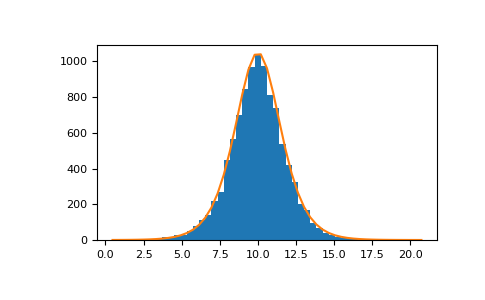numpy.random.RandomState.logistic#
方法
- random.RandomState.logistic(loc=0.0, scale=1.0, size=None)#
从 Logistic 分布中抽取样本。
从具有指定参数(loc(位置或均值,也为中位数)和 scale (>0))的逻辑分布中抽取样本。
- 参数:
- locfloat 或 array_like of floats, optional
分布的参数。默认为 0。
- scalefloat 或 array_like of floats, optional
分布的参数。必须是非负数。默认为 1。
- sizeint 或 int 的元组,可选
输出形状。如果给定的形状是,例如,
(m, n, k),则绘制m * n * k个样本。如果 size 为None(默认),则当loc和scale均为标量时,将返回单个值。否则,将绘制np.broadcast(loc, scale).size个样本。
- 返回:
- outndarray 或标量
从参数化逻辑分布中抽取的样本。
另请参阅
scipy.stats.logistic概率密度函数、分布或累积密度函数等。
random.Generator.logistic新代码应使用此方法。
备注
逻辑分布的概率密度为
\[P(x) = P(x) = \frac{e^{-(x-\mu)/s}}{s(1+e^{-(x-\mu)/s})^2},\]其中 \(\mu\) = 位置,\(s\) = 尺度。
逻辑分布用于极端值问题,它可以作为 Gumbel 分布的混合,用于流行病学,也用于世界国际象棋联合会 (FIDE),其中它被用于 Elo 等级分系统,假设每个玩家的表现是逻辑分布的随机变量。
参考
[1]Reiss, R.-D. and Thomas M. (2001), “Statistical Analysis of Extreme Values, from Insurance, Finance, Hydrology and Other Fields,” Birkhauser Verlag, Basel, pp 132-133。
[2]Weisstein, Eric W. “Logistic Distribution.” From MathWorld–A Wolfram Web Resource. https://mathworld.net.cn/LogisticDistribution.html
[3]Wikipedia, “Logistic-distribution”, https://en.wikipedia.org/wiki/Logistic_distribution
示例
从分布中绘制样本
>>> loc, scale = 10, 1 >>> s = np.random.logistic(loc, scale, 10000) >>> import matplotlib.pyplot as plt >>> count, bins, ignored = plt.hist(s, bins=50)
# 与分布绘制
>>> def logist(x, loc, scale): ... return np.exp((loc-x)/scale)/(scale*(1+np.exp((loc-x)/scale))**2) >>> lgst_val = logist(bins, loc, scale) >>> plt.plot(bins, lgst_val * count.max() / lgst_val.max()) >>> plt.show()
